Meet our experts
Our experts are available for speaking engagements and interviews. To learn more, please contact [email protected].
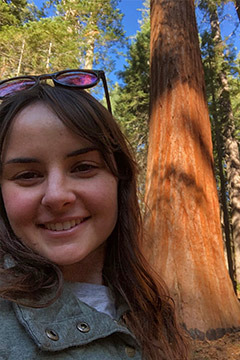
Adrianna Andreucci
Land Protection Manager
Adrianna Andreucci grew up in Auburn, California, in the foothills of the Sierra, but as a child she spent many summers in the coast redwood forest with her father.
“My dad and I took trips to Humboldt Redwoods State Park every summer. That was our thing,” she says. “Looking back, it’s no wonder I ended up where I did. We spent so many summers hiking and biking among those big trees.”
“Purchasing a property outright is wonderful. Under the League’s ownership, we get to steward and manage and nurture it the way we see fit,” says Andreucci. “But partnering with awesome landowners to keep land under their ownership, often lands that have been in a family for generations, while still making sure that sound management endures is really special.” It’s a long-term relationship, and often the process can take years.
The League identifies priority properties—lands with significant conservation values or old-growth characteristics—but Andreucci says they also work with landowners who reach out directly as it’s important to also be opportunistic when the right property comes along.
It’s this long-term impact that drew Andreucci to her position. She grew up with a love of the outdoors, whether visiting Founders Grove in summer or catching crawdads in creeks closer to home, but it was an introductory environmental studies class in her sophomore year of college that opened her mind to new career possibilities. “I never thought I could have a career spending time in the places I love, doing work to ensure the protection of those very places,” she says.
Andreucci earned her B.A. degree in Environmental Studies and Planning from Sonoma State in 2011. One of her positions after graduating was with Greenbelt Alliance, an environmental advocacy group focused on promoting smart growth development and the preservation of open space. Andreucci first joined the League’s staff in 2017, where she served as a conservation programs assistant & associate before moving into her current position in April 2021.
Her busy days include lots of phone calls, mostly with landowners and agency partners. She also spends time in the forest, conducting site visits with donors, staff members, and other stakeholders.
She says the place-based nature of the work is what she loves most about her job.
“I work on a project and it’s so tangible,” she explains. “I can say after it’s done that this piece of land will be protected forever. I become connected to these places in a deeper way.”
Andreucci feels like she has come full circle when she recalls her family ties to the redwoods. Her grandparents both grew up on the north coast in Scotia and Fortuna. Her grandfather told stories of his father, Andreucci’s great-grandfather, working in the Pacific Lumber Company mill and what it was like to grow up in a lumber company town. He died before she started working for the League, but her grandmother, who could remember taking long drives through the redwoods, was thrilled to know she was working to protect those magnificent trees.
Andreucci spends her free time hiking, biking, camping, backpacking, canoeing, and satisfying her endless thirst for outdoor adventures. In the winter you will find her skiing and snowshoeing in the Sierra. More recently, she has been learning to play disc golf. She also enjoys quality indoor time cooking and spending time with her beloved Siamese cat, Zooey.
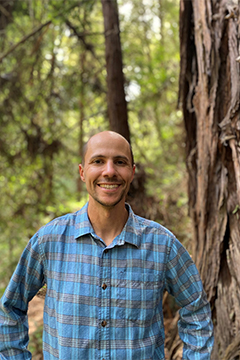
Ben Blom
Director of Stewardship and Restoration
“As a forester, being able to work in the redwoods and sequoias, the tallest and biggest trees in the world—that’s a dream come true,” says Ben Blom, the League’s director of stewardship and restoration.
Raised in the Boston suburb of Needham, Massachusetts, Blom first embarked on his journey to becoming a forester when he landed a job as a wildlife tech for Mendocino Redwood Company. “I packed all my stuff into my little Toyota Corolla and drove up to Mendocino, and that was my first time in California and my first time seeing redwoods,” he says.
“It was a life-changing moment for me.”
“I didn’t know anything about forestry. I was mostly working on spotted owls, seeing how wildlife responds to forest management and vice versa. My job was mostly to find owls and protect those places from logging. Understanding how the actions that we take now can set forests on a trajectory for hundreds, even thousands of years—that was just mind-blowing to me. I learned quickly that I loved this kind of work.”
With more than 15 years of restoration and forestry management experience and a Master of Forestry from the Yale School of the Environment, Blom now leads the League’s large-scale projects designed to rehabilitate California’s iconic coast redwood and giant sequoia forests. These include Redwoods Rising, which aims to restore tens of thousands of acres of historically clearcut forests in Redwood National and State Parks. He also oversees the care and management of all League-owned lands such as Harold Richardson Redwoods Reserve and Alder Creek, as well as the League’s portfolio of conservation easements.
One of Blom’s priorities is leading the League’s work with the Giant Sequoia Lands Coalition. “It is exciting, scary, and intimidating all at the same time,” he says. “We need to get out ahead of the devastating, catastrophic wildfires we’ve seen in the Sierra in recent years. We’ve seen what can happen under the current conditions. It feels like an existential crisis, and at the same time I’m energized to see our coalition mobilizing to do the work.”
Prior to joining the League, Blom worked for the Bureau of Land Management for 12 years, most recently in the role of field manager, overseeing restoration and management operations across 300,000 acres of public land in 10 Central California counties. He witnessed many transformative moments as manager of the old-growth redwood forest at Headwaters Forest Reserve. “Headwaters has this long history of environmental activism with the timber wars. I got to lead tours with whole cohorts of environmental activists that had spent years protecting the area from logging. They had been sitting in trees 20 years before and got to return to see the forest recover. That was really a special thing.”
While at BLM, Blom partnered with the League on various projects. “I was excited to join Save the Redwoods League because I’ve seen that it is guided by science and by its mission in a very pure way,” Blom says. “I also appreciate that the work we do at the League is not easy. In addition to acquiring land, the League is invested in science and in the restoration and stewardship of that land. This kind of work has a long timeline, it’s hard to fundraise for it, and it can be very challenging to work with partners and get things done.”
Even in his spare time, Blom is quite literally always in the forest. “I live in the redwoods. We bought this crumbling house on the hillside, next to the redwoods,” he says. “I feel so lucky that I can basically walk from my backyard down to the road and I’m in the Forest of Nisene Marks State Park. Through the pandemic and everything that was happening, it was a lifeline. It was so important for me and my family to have that release. The number of people that came to this park during the pandemic tripled. Seeing people who were first-time visitors and a lot more diverse families visiting and experiencing the park was awesome to see. The demographics of the visitors here and other public lands I managed for BLM have really changed and diversified in a great way.”
He adds,
“Seeing the resilience and beauty of the redwoods, and the awe that you feel when you’re in a redwood forest—I think that’s why everybody connects with our mission so closely. You don’t have to explain our mission very long to somebody before they say, ‘Oh yeah, let’s do that.’ We need to protect redwoods.”
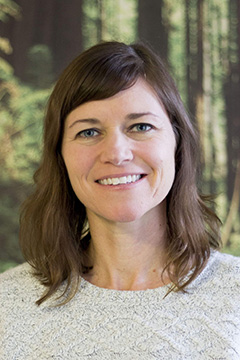
Jessica Carter
Director of Parks and Public Engagement
Jessica Carter’s career is grounded in the importance of diversity and inclusion in the great outdoors. In her early work, she managed a program that highlighted leadership and career development in science, technology, engineering and mathematics for underserved teens at Girls Inc. There, she discovered that the simple privilege of experiencing nature can be a game changer for individuals, entire communities, and the planet.
“We regularly went on field trips that provided opportunities for the girls to both learn and take positive risks – outdoor experiential programs offered an unparalleled platform for this,” says Carter. “The girls were engaged and inspired each time we went on an adventure, from hiking or cross-country skiing to kayaking, and I saw how this translated into new perspectives on their everyday lives.”
After a decade of growing partnerships to enhance visitor access and programs at Golden Gate National Recreation Area – where she also led partnership development for a $38 million Alcatraz embarkation site and visitor welcome center – she joined Save the Redwoods League as Director of Parks and Public Engagement in 2018. Her expertise in managing nonprofit, commercial, and interagency partnerships is valuable in expanding the League’s parks support, education, interpretation, and public outreach projects.
Carter’s work embodies a critical issue that has been emerging as a key to conservation: engaging communities that have previously been underrepresented in the movement, and possibly even felt excluded from enjoying natural spaces. “As society becomes increasingly ethnically and socioeconomically diverse, everyone must come to appreciate the value of redwood forests to ensure their protection,” Carter says.
And there is, of course, an even bigger picture. She adds, “Bridging equity gaps doesn’t only serve the conservation purpose, but it also plays a key role in the wellness and prosperity of our society at large. I’ve seen how environmental education and access to the outdoors expands confidence, perceptions, and interests, all of which contribute to the foundation of personal success. Redwoods experiences can serve as a great equalizer in this respect, particularly for low-income communities that may not have access to many alternative resources.”
Carter will cultivate the League’s education programs and park projects, such as the future visitor center at Redwood National and State Parks. She’ll be collaborating closely with partners, parks agencies, and indigenous tribes, among others, to define and engage specific audiences in the League’s Centennial Vision, providing more and more people the opportunity to tap into the magic of the redwoods.
“I’ll never forget the first time I went to Muir Woods National Monument after starting my job with the National Park Service. Being surrounded by the majestic redwoods in the deep quiet of the forest was powerful,” Carter says. “In fact, late in my pregnancy with my son, I woke up one morning with a burst of energy and went on a hike through Joaquin Miller and Redwood Regional parks in Oakland, and then promptly went into labor an hour after returning home. So redwoods have a very special place in my life now.”
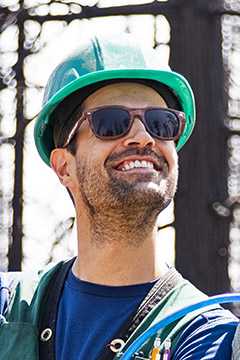
Anthony Castaños
Land Stewardship Manager
Anthony Castaños grew up in San Diego and took frequent trips to the Sierra with his family. He credits solo time exploring the chaparral and forests for his deep comfort in wild places.
“As a kid I would just leave to wander in the woods for hours, not knowing where I was or how to get back, but somehow I always managed to get home,” he says. “I like to joke that I never get lost in the woods; I just get delayed.”
Anthony Castaños grew up in San Diego and took frequent trips to the Sierra with his family. He credits solo time exploring the chaparral and forests for his deep comfort in wild places.
“As a kid I would just leave to wander in the woods for hours, not knowing where I was or how to get back, but somehow I always managed to get home,” he says. “I like to joke that I never get lost in the woods; I just get delayed.”
Castaños earned a B.A. in Urban Studies from the University of California at Berkeley and quickly learned that mastering the skills of a project manager gave him versatility in his career choices. As land stewardship manager, Castaños oversees all of the League’s held properties and conservation easements, which are scattered throughout the redwood range from the Oregon border to Big Sur.
It’s a broad role. A typical week includes several days out in the forest, checking on properties, and ongoing restoration projects. He stays in contact with dozens of contractors and seeks grant funding for restoration projects on these properties. Though not required, sometimes he pulls on boots and works alongside crews doing chainsaw work and data collection.
Castaños says the restoration projects are even ramping up in light of a growing awareness: that simply preserving land through ownership or conservation easement isn’t enough.
“For most of the past 100 years, Save the Redwoods League bought land, transferred ownership to an agency, and said, great, it’s protected,” he explains. “But with climate change, the accumulation of fuels, and the need to incorporate Indigenous people’s historic land management practices, we’re realizing these lands can’t just be left alone.”
The scope and intensity of wildfires over the past several years is the driving motivation for land stewardship. The biggest focus is on fuels reduction—hand crews in the forest doing the time-consuming but necessary work of thinning small trees and removing “ladder fuels” that carry fire up the tree. “That way, when a fire does come through, it will just burn on the ground floor rather than up into the canopy where it can cause a lot of damage,” explains Castaños.
In addition to overseeing ecological thinning projects, Castaños has also begun managing prescribed burns. “It’s been quite a thrill to get that work done because we’ve seen very positive results,” he says, pointing to a prescribed burn completed in February of 2020 in the Santa Cruz Mountains as a case in point. An intense wildfire burned through the area later that year.
“All the trees outside the prescribed burn were burned head to toe,” recalls Castaños. “But the trees within the prescribed burn area were still green and had healthy canopies.” Castaños foresees this restoration work expanding as the state embraces the need for active management. Castaños first joined the League in early 2011 as the conservation programs assistant and has since been promoted three times. He’s been in his current role since 2016.
“I feel like I have a lot of institutionalized knowledge,” he says. “I can reference past projects, past relationships, and partners.” This deep knowledge has been critical for helping facilitate new projects and figure out how to accomplish them.
When he’s not working, Castaños spends much of his free time volunteering: planting trees with Friends of the Urban Forest, packing food at the San Francisco-Marin Food Bank, and mentoring kids at an after-school program in the Tenderloin neighborhood in San Francisco.
If doing good work is critical to Castaños’ personal happiness, so is living in the state of California.
“When I drive along the 101 and see the ocean, the cliffs, and the redwood trees, I find it so beautiful and captivating,” he says. “I cannot imagine living anywhere else.”
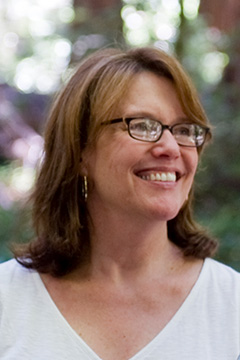
Catherine Elliott
Senior Manager of Land Protection
Catherine Elliott spent much of her career as a regulator on forestry and environmental issues, and she considers that experience invaluable in her current role.
While the process of protecting the redwood forest typically involves a great deal of scientific and legal analysis, success often depends on basic human interactions.
“Relationships in this line of work can become both close and nuanced,” observes Catherine Elliott, the Senior Manager of Land Protection for Save the Redwood League. “The favorite part of my job is getting to know the landowners who become our partners in preservation. Many have forestry backgrounds, but they come from all walks of life. I learn a lot from working with them, and it’s great getting to know them.”
Landowners differ in opinion on conservation issues, says Elliott, but she observes most share a common bond.
“They know their land, and they have a deep and abiding love for it,” she says. “They want to preserve and enhance it, and that’s why they to choose to work with the League.”
As an example, Elliott cites her work with an old-growth redwood mill in Mendocino County. The League recently partnered with the mill to save 400 acres of old-growth redwoods along the Noyo River.
“The company had purchased the parcel and was planning to log it,” recalls Elliott. “We didn’t take a position on their timber harvest plan when we began negotiations because if we had stood against all logging, it would’ve just stopped the negotiations. We were interested in determining if they were willing to sell the property, so that’s where we started the conversation.”
Elliott says the mill’s executives were open to the possibility of a land sale and were forthright and honorable in their negotiations.
“They were very gracious and open,” Elliott says. “Eventually we were able to purchase the property, which has since been transferred to the Mendocino Land Trust for management. No cutting is allowed except for forest restoration and fire protection. It was an agreement that worked for everyone, and we established a wonderful relationship in the process.”
Old-growth forest acquisition and preservation remains a priority for Elliott, but her mission also has expanded to a broader purview.
“With 95 percent of the old-growth redwoods already cut, our vision and methods will change for the League’s second hundred years,” says Elliott. “We’re looking to acquire or establish conservation easements on properties that will buffer and connect old-growth forests, and we’re working on restoration programs to accelerate old-growth characteristics in younger forests. I’m excited about working on the landscape-scale projects that these goals require.”
Elliott spent much of her career as a regulator on forestry and environmental issues, and she considers that experience invaluable in her current role.
“That’s essential work, and I respect it deeply,” she says. “But I’ve spent ten years with the League, and I’ve become tremendously invested in the collaborative process that’s our hallmark. It can be extremely effective simply because it’s not adversarial. The whole point is to look for mutually beneficial solutions, rather than a zero-sum win, and I find that incredibly satisfying and inspiring. In the most basic terms, I just like discovering common ground with people.”
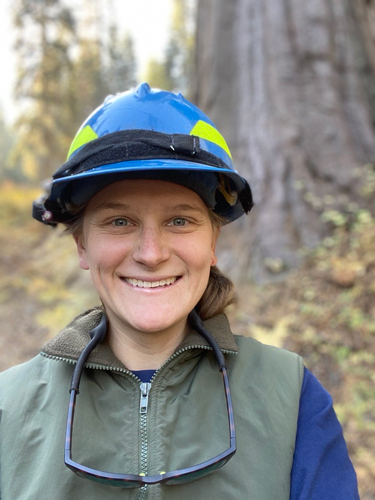
Linnea Hardlund
Forest Ecologist
Hardlund’s role in the League’s Science and Research program takes her into the giant sequoia range frequently now, often to the League’s two Sierra properties: Alder Creek and Red Hill for myriad projects from planning prescribed burns to assessing ecological impacts of wildfire in the groves. Her experience working for the National Park Service on fire ecology and wildland fire crews, in which she led research crews and participated in prescribed burns in giant sequoia groves, along with her academic background, gives her a unique, valuable perspective on the many challenges facing giant sequoia today. At the top of that list of challenges is wildfire.
Linnea Hardlund remembers well the moment her passion for giant sequoia began. She was 7 years old. Her father, an immigrant who was adamant his kids would see the natural wonders of the United States, took his family on a trip to a trip to Sequoia National Park. “OK, you guys, giant sequoia are really big trees,” he said. “You’re not going to be able to fathom how big they are, but you’ll know a sequoia when you see it.”
As they drove up Generals Highway, they kept asking if this or that tree was a giant sequoia, but he said, no, those are ponderosa pine. When they finally got into the Giant Forest, there it was, the first sequoia. “I was absolutely blown away,” she recalls now. “Dad was right, we truly couldn’t fathom just how big and majestic they are. I remember standing there trying to wrap my head around how old they were, and everything they had endured and seen in their lifetime, and I was simply speechless.”
Hardlund’s role in the League’s Science and Research program takes her into the giant sequoia range frequently now, often to the League’s two Sierra properties: Alder Creek and Red Hill for myriad projects from planning prescribed burns to assessing ecological impacts of wildfire in the groves. Her experience working for the National Park Service on fire ecology and wildland fire crews, in which she led research crews and participated in prescribed burns in giant sequoia groves, along with her academic background, gives her a unique, valuable perspective on the many challenges facing giant sequoia today. At the top of that list of challenges is wildfire.
Giant sequoia have thrived alongside wildfire in the Sierra Nevada for millennia. In fact, fire helps the great trees reproduce by releasing seeds from their cones. But for decades, well-intentioned land managers have suppressed the Sierra’s normal wildfire cycles, allowing unnatural overgrowth of shrubs and smaller trees. This fuel, combined with unprecedented dryness and weather patterns associated with climate change, is feeding severe wildfire that is overwhelming the defenses of the giant sequoia.
Thousands of the oldest, largest giant sequoia were lost in the 2020 Castle Fire, and it is likely that many more were lost in the wildfires of 2021.
“I’m early in my career, and whether I like it or not, I have started to become sort of a field expert on fire mortality of giant sequoia,” Hardlund says. “My job is to study the health of giant sequoia and devise strategies for their conservation, and in recent months my focus has increasingly been to assess the impacts of wildfire. Before 2020, it was possible that I had seen more torched monarchs than anyone else in the world, and that’s because this is totally unprecedented—more experienced experts in this field have never seen this at this scale before.”
Even though looking at this much loss is saddening, Hardlund is driven by the desire to save what’s left.
“This is all happening on our watch,” she says. “We have a responsibility to ensure that these trees endure.”
Part of that work involves doing research to understand the impact of the recent fires in the range, working with colleagues to figure out what conservation measures will protect the trees from future severe wildfires, and then getting that work started on the ground.
While she is doing this important work, Hardlund also is returning to school to get her master’s degree in forestry and fire ecology from the University of California, Berkeley.
Hardlund’s love for giant sequoia is a subset of her love of plants and botany. She started her career as a field botanist on post-fire research in Yosemite National Park, which lead her to take the giant sequoia forest fellow role at the League years later.
“My first recollection of understanding my namesake, the delicate alpine flower named after Carl Linnaeus, and learning how to key plants in Yosemite on our yearly family camping trip to various national parks,” she recalls. “Being in nature and learning from it—that’s where I want to be.”
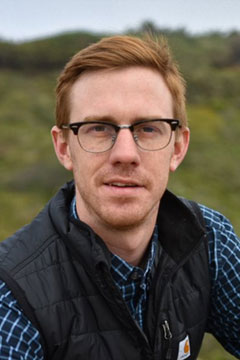
Mitchell Hayes
Partnership Manager
In 2015, Mitchell Hayes graduated with a B.S. in Project Management from California State University, Chico. He took on project management positions for a few different organizations, but he craved a role that was more fulfilling. So, he decided to take a step back.
“I knew natural resources was of high interest to me, and I wanted to be able to use the skills I’d gained in college and in practice and apply those to relatable areas in natural resources,” says Hayes.
For nearly two years, Hayes worked as a seasonal park ranger and aide for California State Parks and California Land Management in Placer and Mendocino counties. In these roles he interacted directly with visitors and became intimately familiar with the natural landscapes of the parks, including Standish-Hickey State Recreation Area, Richardson Grove State Park, and Hidden Falls Regional Park. Soon after, he went back to school, earning an MBA in Strategic Sustainability from Humboldt State University. He accepted the role of partnership manager with Save the Redwoods League in the summer of 2021.
In this role, Hayes administers Redwoods Rising, a collaborative effort to accelerate redwood forest recovery within Redwood National and State Parks and to help protect the remaining old-growth groves there.
Hayes views himself as the connective tissue among the partners, which include the League, the National Park Service, and California State Parks. This translates into frequent meetings and lots of communication.
“My value to the project is doing the behind-the-scenes work and keeping everyone in the loop,” says Hayes. “A huge component of my job is relationship building, not only with partners but with funders of the project.” Coordinating tours and presentations for funders and other parties helps them understand what their generosity has helped accomplish on the ground.
The restoration projects coordinated under Redwoods Rising are aimed at rehabilitating crowded second-growth forests, restoring streams, and decommissioning the many miles of defunct logging roads that wind through these forests.
“It’s gratifying to be part of a transformation, as forests that were treated poorly are stewarded back into health,” says Hayes. “And knowing, too, that old-growth forest helps with carbon sequestration, and that restoration work helps increase wildfire resilience.”
But even more important, says Hayes, is being part of a complex and successful collaborative where projects of such scale and importance are possible.
“Being part of that model and being able to share that knowledge is one of the most important parts of my job,” he says.
Currently, about $30 million in public funds has been committed to Redwoods Rising. Hayes is tasked with planning and tracking budgets with all of the granting agencies. He also meets regularly with the League’s other departments, helping convey the importance of the initiative and keeping colleagues updated on the latest developments.
Through his experience administering projects of all types, Hayes has learned that conflicts are inevitable.
“Knowing how to communicate and what to say in those delicate moments is a skill I’ve found to be universal to all project management-related roles,” says Hayes.
His natural proclivity for understanding different points of view make him particularly well-suited as the administrator of a complex collaborative partnership.
“Being able to be that connective tissue—to take the middle ground—is very beneficial,” says Hayes. “It’s not that I know exactly what decision to make, but I’m very good at hearing from everybody first and facilitating a decision.”
Hayes loves to play where he works, and he blows off steam four or five days a week on his mountain bike. He rides all over Humboldt County. Blue Lake, Arcata Community Forest, and Paradise Royale near Shelter Cove are some of his favorite places to ride. He also enjoys camping, backpacking, and kayaking.
He grew up in Santa Cruz County, on the southern end of the redwood range.
“The landscape on the North Coast is very similar to Santa Cruz and very near to my heart,” says Hayes. “It’s a huge reason why I’m doing this kind of work.”
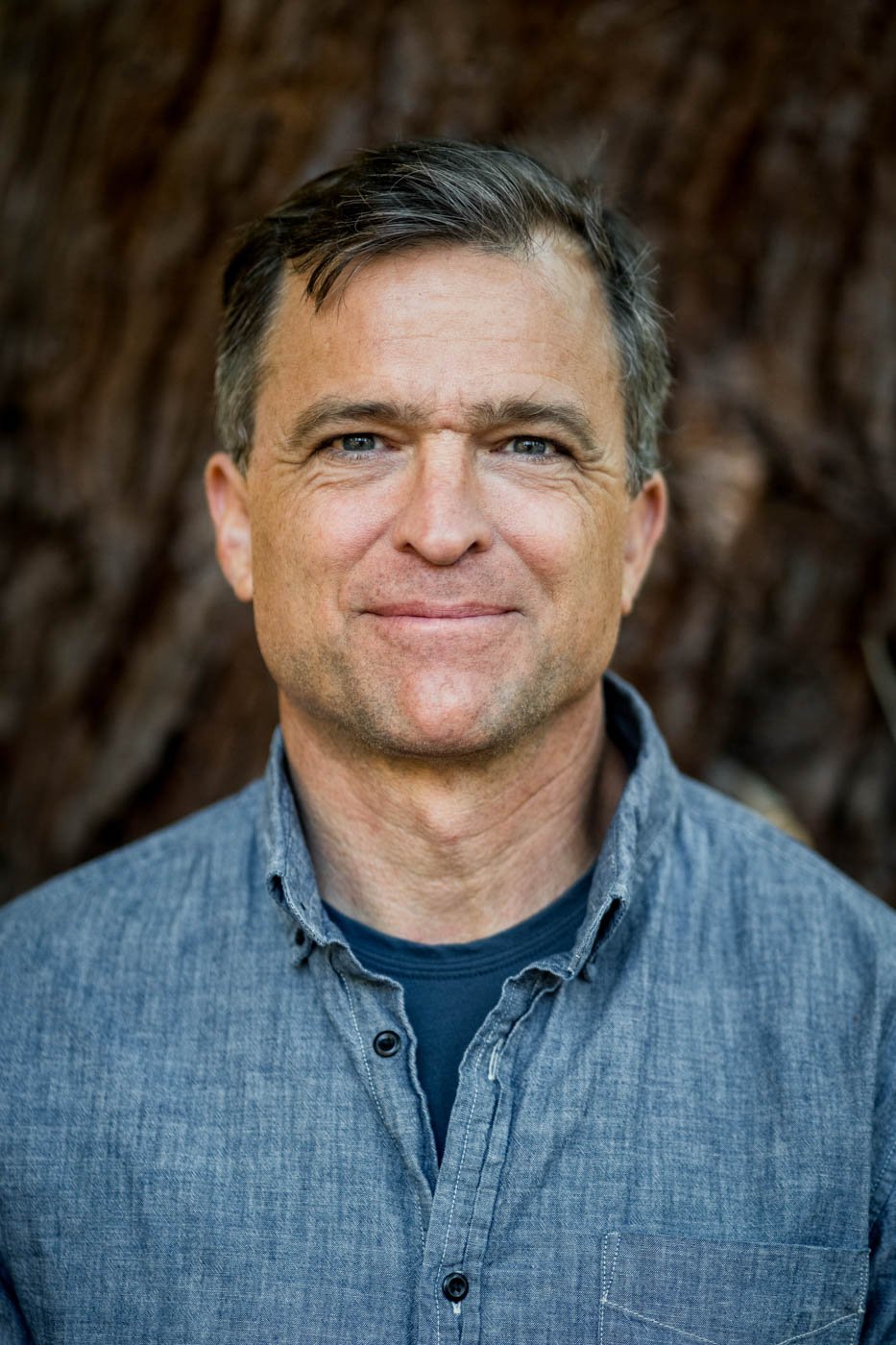
Sam Hodder
President and CEO
Sam Hodder, the President and CEO of Save the Redwoods League, takes the long view on his role and blends it with the urgency of the moment. That’s appropriate, given his mandate of protecting redwoods – some of the oldest living things on the planet, which stand today because people like Hodder were determined to protect them over the last 100 years.
As the League enters its second century, says Hodder, its vision and methods are evolving in response to the dynamic forces now at play in both the redwood forest and the broader community in which we work.
“The League is lucky to have one of the best reputations and strongest staffs in the conservation world,” he says. “Our scientists are conducting cutting-edge research in the redwood forest; our land team is advancing a transformational portfolio of complex land transactions to protect ancient redwoods and the younger recovering forests that will sustain them; our stewardship team is in the field accelerating the regeneration of formerly logged redwood stands; and our education team is bringing redwood science into urban classrooms, and urban students into redwood parks. They all are doing important work at a critical time, and my job is to make sure that they have what they need to get it done.”
Since joining the League, Hodder has lead the team in the permanent protection of more than 20,000 acres of redwood lands and the implementation of ambitious forest restoration projects. He has guided the development of the League’s Centennial Vision, a bold 100-year plan to accelerate forest conservation and the regeneration of coast redwood and giant sequoia forests across their range and to dramatically enhance visitor experience in the redwood parks. He has further advanced the League’s Redwoods and Climate Change Initiative, a project that has led to pioneering research on the unique ecosystems thriving in the old-growth redwood canopy. Hodder also has provided greater focus the League’s investment in educational programs and redwood park public access improvements.
Hodder grew up in New England and spent much of his boyhood exploring the trails of Maine, Vermont and New Hampshire. While studying at Princeton University, he worked summers on trail crews for the Appalachian Mountain Club (AMC) in New Hampshire’s White Mountain National Forest.
“Ever since my first summer job building hiking trails, I have been inspired by the role of accessible open space in our communities,” says Hodder. “The White Mountains are the wilderness playground for the cities of the northeast, and every summer the trails fill with Cub Scout troops, inner city camping programs and pavement-weary families from all walks of life.”
“As we worked the trails each summer, there was a nearly constant stream of hikers wandering past in the midst of an experience they would never forget,” Hodder continued. “I was proud to have a hand in getting people to these beautiful places and to feel connected to that collective experience. As a country, we have worked hard to set aside special places for all of us to share. From city parks to national wilderness areas, we have made a choice in the ‘democratization’ of natural beauty because, quite simply, time spent in the wonder of the outdoors makes our lives better. It makes our communities stronger, our families happier, our life experiences richer and our bodies healthier.”
After graduation, Hodder sought work in land conservation, working at the Trust for Public Land (TPL) for the next 22 years and ultimately serving as TPL’s Maine State Director and California State Director. He joined Save the Redwoods League as President and CEO in 2013.
As he shepherds Save the Redwoods League into its second century, Hodder feels fortunate to have found a career that aligns so completely with the things he cares most about. He spends much of his free time exploring the wildlands of the West with his wife, Kendra, and their four sons, and he takes great pride in that, together with his colleagues at Save the Redwoods League past, present and future, he has played a role in saving our most special places.
“Spending time in nature is transformative,” Hodder says. “Whether on the forested trails of the White Mountains or the standing among the mighty ancient redwoods, you come out a better person. We need these places now more than ever, and there is no more fulfilling challenge than ensuring that future generations will have the benefit of a thriving, resilient redwood forest to inspire them.”
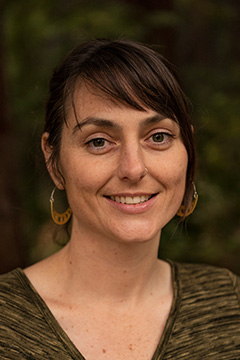
Laura Lalemand
Senior Scientist
Laura Lalemand grew up in Maine, a state notable for stalwart individualism, a rugged coastline, abundant lobsters, and a vast, forested interior. She loved the place, largely due to the role the outdoors played in her daily life.
“You were never far from a lake or river,” Laura recalls. “Anytime you wanted you could just take a hike, go swimming in a pond, go fishing or canoeing. There was a simplicity to it all that was incredibly satisfying.”
That connection to the wild and all the living things in it led her to a Bachelor’s degree in biology from the University of Maine at Farmington. After graduating in 2007, she went west, taking a position as a biological science technician with the U.S. Geological Survey. Laura worked on various projects in the Sierra Nevada, northern California, and southern Oregon for the USGS, with much of her effort focused on tree growth, mortality, drought response, and forest restoration. She joined Save the Redwoods League as a forest fellow in 2016 and completed her Master’s degree in Forestry from Humboldt State University in 2018. She was hired as a forest ecologist by the League at that time and is currently working with her colleagues on Redwoods Rising, the seminal and deeply ambitious partnership involving the National Park Service, California State Parks, and the League to restore 120,000 acres of degraded forest in Redwood National and State Parks.
“I’m inspired by the vision of Redwoods Rising, and I’m honored to be a part of it,” Laura says. “This collaboration will allow us to restore forest ecosystems on a landscape scale. More than that, we’re working to accelerate old-growth characteristics in second-growth and third-growth forests. Our work will allow these young, degraded forests to progress to a more dynamic and resilient mature state far sooner than would occur if they were simply left alone. I also see Redwoods Rising as being a model for future collaborations who are working together on integrated, landscape-level restoration and land stewardship.”
“Prescribed fire, or controlled burning, is a valuable tool for forest restoration,” Laura observes. “It allows us to reintroduce the natural process of fire back onto the landscape in a controlled manner, on our terms. Fire is a critical component in many western forests, including redwood forests. I believe it’s essential that we develop healthy relationships with fire, allowing it to fulfill its important, ecological role in fire adapted systems and to assist in fuels reduction and wildfire management.”
“That said,” Laura notes, “every prescribed burn is unique and forest type and structure, terrain, fuel loading, and climatic variables all need to be taken into consideration when developing a successful prescribed burn plan.”
“We also have to address the political and educational aspects,” Laura says. “People need to understand why fire is a valuable restoration tool, and we need to show them how it works. We need to be educators as well as forest managers.”
The best part of her job, says Laura, is that it allows her to contribute to an all-encompassing vision of conservation.
“The League is working toward a convergence of forest conservation, restoration, and land stewardship at the largest possible scale, and I find that incredibly exciting,” she says. “We’re not just working to restore and maintain redwood forests. We’re working to conserve all the associated species that depend on ancient redwoods. We’re integrating in-stream aquatic restoration, road removal and soil stabilization, forest restoration–everything that affects the redwood ecosystems. And we’re doing it as an equal partner with other agencies and groups, collaborating to define and sustain our long-term mission. I find this work very important and satisfying.”
Much of Laura’s spare time is spent enjoying the Humboldt and Del Norte County coastlines and ancient forests.
“I love canoeing, hiking, and just exploring the woods,” she says. “I also enjoy fiber arts, growing and preserving food, raising chickens, ducks, and geese, and connecting with others while building community.”
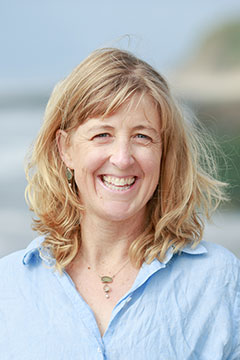
Joanna Nelson
Director of Science and Conservation Planning
“I love environments on the edge—and coast redwood forests fit in this category—the back and forth between forests, rivers, and coasts,” says Joanna Nelson, the League’s director of science and conservation planning. “In-between places are inspiring to me, and that has been across fields of study, across communities. I really like being a bridge between different communities or different ways of doing things.”
Read more »
During college, Nelson led wilderness trips and worked as a wilderness ranger in the Sierra Nevada. With the goal of solving environmental problems, she ultimately earned her Bachelor of Science and Master of Science in Earth Systems at Stanford University, and her doctorate in Environmental Studies (Ecology) from the University of California, Santa Cruz. She also served as a postdoctoral fellow with the Natural Capital Project at Stanford University and as a NatureNet Science fellow for The Nature Conservancy and Stanford.
As an expert in forest, coastal, and fire ecology, Nelson has more than 25 years of experience in conservation sciences. She directs the League’s scientific research programs, including the Redwoods and Climate Change Initiative, Redwood Genome Project, and Research Grants programs, in addition to applying her understanding of wildfire and drought effects in the coast redwood and giant sequoia ranges.
“I’m excited to take care of League landscapes and learn what’s happened on them after the last few years of fires,” Nelson says. “Despite the coast redwoods’ and giant sequoias’ innate fire resilience, we now have big, high-severity fires that just take them out. The giant sequoia mortality of last year and this year is devastating, and at the same time I know I will never give up, and the League will never give up, on these forests and land care. We have a climate-disruption situation and climate action to take.”
Before joining the League, Nelson was the founder and principal of LandSea Science, where she built interdisciplinary teams to create conservation solutions that support ecosystem resilience and the well-being of humans and nature. In this role, she was an invited collaborator working with Indigenous communities and land trusts, supporting evidence-based actions on climate change.
“It’s always been important to me to bring in communities,” Nelson says. “Scientists can tend to helicopter into a place and tell the people who live there about the place and the processes. But of course, people know important things about where they live. It should be an exchange, a conversation.”
Three hundred miles west of Fairbanks on the Yukon River, Nelson worked with Indigenous Koyukon Athabaskan people on climate change and wildfire and what that means for subsistence livelihoods, including hunting moose and caribou, fishing for salmon, and gathering berries. This work had a profound influence on her approach to scientific research and how it intersects with tribal engagement, consultation, and consent.
“A lot of Indigenous communities experience ‘researcher fatigue,’ which refers to communities being tired of researchers coming through and studying them, taking from them,” Nelson says. “So for me, tribal engagement has a lot to do with transparency. I communicate my intentions, what I’m interested in, what I promise to give back—and then I follow through on that. For example, I can share what I’ve learned about how blueberries and lingonberries grow in places that have burned anywhere from one to 30 years ago, and that they grow really well about three years post-fire.”
Getting actively involved with the community helped facilitate conversations as well. “I volunteered in the community garden. Softball is the game in the village and I play really badly, but I showed up and I played. I got through some of the layers of misperception by showing up,” she says. “I was so honored to be invited to Spirit Camp, where Indigenous elders were teaching subsistence lifeways to youth. We were cutting up salmon to smoke and dry for winter, with a traditional, curved knife called a klabaas. One of the elders said to me, ‘Well, you’re not very good at cutting fish, but you did it all day, and I appreciate that.’”
Her experience helped while working in the field with Native stewards from the Amah Mutsun Land Trust, an initiative of the Amah Mutsun Tribal Band to return to their ancestral lands and restore their traditional stewardship. “I think it mattered to them that I worked with Native people in Alaska. And again being transparent about who I am—non-Indigenous—and that I understand that I don’t ever speak for the tribe, that I’m there because they’ve asked for my university training to complement what they know as they re-learn their traditional knowledge.”
In addition to being a scientist, Joanna is a hiker, a surfer, and an aikidoka. “Aikido is a martial art of peace, and it has been truly important to me through the pandemic. You do Aikido with other people on the mat, and there’s also a solo spiritual practice—a series of motions and chanting. That’s been a rock for me, this practice that we usually do in physical contact, and then in our adaptive way we are doing by ourselves on Zoom, but together.”
On a camping trip in the redwoods along Joy Road off Bodega Highway in Sonoma County, Nelson celebrated her first birthday. While that memory exists only in a photo, which she still has, some of her early recollections from childhood include rainy hikes in the redwood forests of Sonoma County with her parents and sister. “I can remember our orange raincoats and seeing what comes out in the damp woods: mushrooms, banana slugs, and that smell of rain,” Nelson says. “Now my husband and I have two children. He is also an ecologist, and he’s an environmental lawyer and planner. While working to keep environmental doom out of our home, our children are definitely the kids of two biologists; they get an earful about climate action, collaborative conservation, stewardship and tending to land and life, as well as hearing ‘get outside!’”
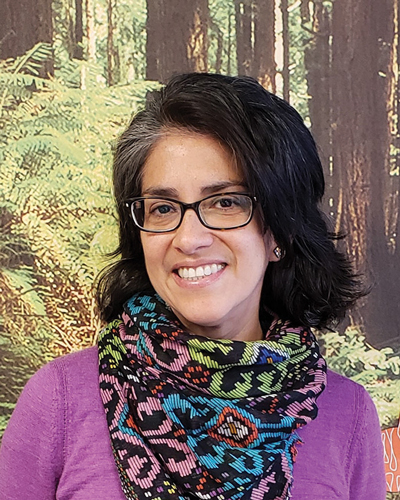
Leslie Parra
Outreach Program Manager
One of the great challenges facing the conservation community is reversing years of historical practice and ensuring that people of all backgrounds not only can benefit from the outdoors, but also feel welcome in these places that many of us take for granted. Leslie Parra’s professional calling is cultivating enrichment programs with multicultural and international perspectives. She got a firsthand view of how Save the Redwoods is addressing that challenge even before her first day on the job, when she joined a League field trip with outdoor leaders from underrepresented communities. The group explored the League’s Harold Richardson Redwoods Reserve, an old-growth grove in the remote hills of Sonoma County.
As the League works to turn Harold Richardson Redwoods Reserve in the first new ancient redwood park in a generation, the organization sought the group’s insights as it moved forward in public access planning.
“That trip in the redwoods showed a lot of intention, which is really the easy part,” Parra recalls. “But hearing our guests talk about the obstacles they had faced with traditional conservation organizations really demonstrated the challenges the League faces and the hard work ahead building trust with diverse communities.”
Parra is anxious to do the hard work of connecting these diverse communities to coast redwood and giant sequoia forests. She has garnered recognition for her leadership in community civic action, STEM and environmental education, and diversity, equity, and inclusion work over the past 15 years.
“One of things I’ve learned in doing this kind of work is that good things always happen when the community expands,” Parra says. “When we grow the community around redwoods, it will not only benefit those who have been historically excluded, but it will also be better for the parks and trees themselves.”
Immediately after her arrival at the League, Parra helped the organization identify four communities that have been underrepresented in redwood parks: families and young adults of color; and women and girls. Since then, Parra has led the League’s efforts to cultivate relationships and programmatic partnerships with community-based organizations, public lands managers, and leaders within these communities.
COVID-19 prevented Parra and the League from holding in-person events in 2020, but that didn’t stop her from finding creative ways to engage. For instance, planned hikes through the redwoods with Latino Outdoors turned into a series of terrific videos hosted by that organization’s experts. And Parra opened a new line of communication through a podcast called “I’ll Go If You Go,” by and for diverse conservation and outdoor recreation leaders that strives to build community through conversation and expand access to the redwoods and partnerships for the League.
“When you’re trying to build relationships with new audiences, it’s important to get out of your comfort zone and go where they are,” Parra says. “Sticking to the old ways of doing things is how conservation organizations lost their trust with these communities in the first place.”
One of things driving Parra’s desire to connect the League with these communities is they share the great natural experiences that she enjoys in the San Francisco Bay Area. During her free time, she loves to go hiking with her partner Eric and their dog Mishqui (which means “sweet” in Quichua, the native language of Ecuador—a place she calls home).
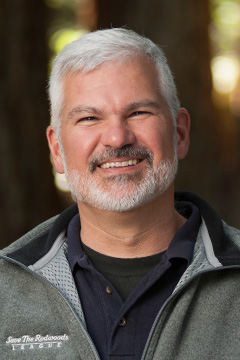
Paul Ringgold
Chief Program Officer
Paul Ringgold has been an outdoor enthusiast his entire life, and about 10 years ago he and his wife took a hike. It was through a particularly beautiful part of California — an ancient redwood forest at Prairie Creek Redwoods State Park, to be exact. And as the couple strolled among the behemoth trees, Ringgold felt a certain longing.
“I realized how happy I’d be if I could somehow find a way to help preserve these kinds of forests,” Ringgold says. “That walk through Prairie Creek somehow crystallized my priorities. It made me realize what I really wanted to do with the rest of my life.”
Luckily for Save the Redwoods League, those ambitions have been realized. Ringgold has worked in conservation and land management for more than 30 years, serving as a Forest Policy Analyst for the Pinchot Institute of Conservation, a Forest Manager and Research Program Director for the University of Washington, and the Vice President of Land Stewardship for the Peninsula Open Space Trust. As the League’s Chief Program Officer, he oversees all land conservation transactions, land stewardship and management activities, forest restoration programs, public funding and policy engagement, park support, as well as education and interpretive programs. He also establishes specific priorities for the breadth of the League’s programs.
“At this point, my interests have come back full circle to forest management and conservation,” Ringgold says. “I started my career as a forester in the Pacific Northwest. And while I deeply enjoyed my subsequent work in research, policy and land conservation, which included rangelands and farms as well as timberlands, I’ve felt this deep pull to reorient to forests — the redwood forest in particular.”
Ringgold is particularly excited to work with Save the Redwoods League as the organization prepares to celebrate its Centennial. The League, he observes, is launching a bold set of initiatives that will both honor its historic mission and expand its purview to meet the challenges of climate change and accelerating natural resource demands.
“In the coming years, we’re going to have to both balance demands among stakeholders and prioritize among our own efforts,” says Ringgold. “That doesn’t mean compromise — ultimately, the restoration and ongoing preservation of the coast redwood and giant sequoia forests throughout their ranges remains our immutable goal. But how and when we get there is of paramount importance. We have to be as smart in the way we approach the challenges of the coming century as our founders were in addressing the pressing issues of the League’s early decades.”
Ringgold holds a Master’s degree in Forest Policy and Rural Sociology from Yale University and a Bachelor’s degree in Forest Resources Management from the University of Washington. In addition to his work at the League, he serves as the Advisory Council Chair of the Bay Area Open Space Council.
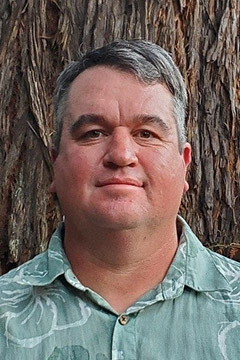
Spencer Stiff
Redwoods Rising Field Operations Manager
Spencer Stiff knows the forests and streams of the North Coast intimately. He grew up west of Willits, CA, at the edge of the redwood belt. Before joining Save the Redwoods League, he spent his career as a fish biologist, hatchery manager, roads superintendent, and logging contracts administrator. Over the course of 11 years, he held a number of positions with Green Diamond Resources Company. Much of his work there focused on roads and ensuring logging operations did not negatively impact fish and their habitat.
Stiff is pleased to support the mission of Redwoods Rising and to help usher redwood groves on their way to becoming old-growth forest. The projects under his purview take place in two focus areas: greater Prairie Creek, west of Orick, and Mill Creek, south of Crescent City.
“We’re doing biomass removal with variable density thinning and also ‘lop and scatter,’ where we thin trees and leave them on the ground,” he explains. He also oversees the decommissioning of roads and road reoccupation, where old roads that haven’t been used in decades are cleared so crews can access stands that need thinning.
Stiff is the on-the-ground point person for these projects. On a typical day, he might meet with park inspectors and contractors, prepare for upcoming projects, and solve problems that inevitably come up.
Stiff earned a B.S. in Freshwater Fisheries from Humboldt State University in 2002. An avid fisherman, Stiff spent 10 years as a river guide for salmon and steelhead. He loves both freshwater and ocean fishing and still owns a drift boat and a jet boat.
His role with the League enables him to spearhead work that will help improve conditions for fish. Decommissioning roads, for example, will help stem the erosion that can cloud creeks.
“We’re also pulling lots of crossings that were delivering sediment to Class 1 creeks and smaller Class 2 tributaries,” says Stiff. “A lot of them were completely buried.” Unearthing those streams and removing the fill material will allow gravel to move down the creeks into larger streams, where they can provide high-quality spawning and rearing habitat for salmon and other fish.
Stiff has also started implementing aquatic restoration projects, working with contractors to place whole logs with intact “root wads” into streams, where they can help slow the movement of water and help create ideal habitat for young fish.
Stiff is striving to make all of these projects more efficient so that grant money and donations can stretch farther.
“I would like to get as many miles of road removed as we can and as many acres of thinning completed as we can with the grants and funding that we have,” he says.
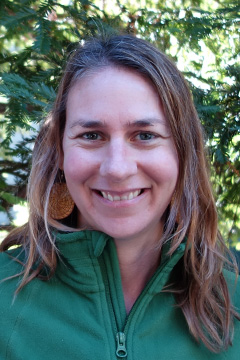
Deborah Zierten
Education and Interpretation Manager
Protecting, connecting and rejuvenating the redwood forests demand ample hands-on work, but the process is predicated on hearts and minds. Unless people understand the significance of redwood conservation, they won’t support the projects forest restoration requires. “The best way to reach adults with our message is to inspire them when they’re children,” says Deborah Zierten, the League’s Education and Interpretation Manager. “Children find redwoods fascinating – thrilling, even! We don’t have to convince them of their importance. They’re so often captivated by the forests’ beauty and grandeur, and they understand the importance intuitively when they’re presented with the facts.”
“We need to do both,” she observes. “The schools offer our best opportunity for replicable programs across the entire redwood range. For high schools, we provide a redwood forest program that ties into climate change and carbon sequestration. Our curricula are locally focused, so that kids can conduct hands-on research almost literally in their backyards.”
The League also has an elementary school program, Explore Your Watershed, Zierten says.
“We take students on field trips to redwood forests in the upper reaches of their local watershed and to the San Francisco Bay,” she says. “They’re taught how it all is connected, and how the health and integrity of the coast redwood forest can ultimately affect water quality in the Bay. For many of these kids, our field trips provide their first visit to a forest. It’s incredibly moving to watch them becoming engaged with the redwoods, to see them explore the connections between critical natural systems.”
Such youthful enthusiasm is infectious, Zierten notes, and that’s an essential factor in redwood conservation outreach.
“A truism in this work is that you teach the kids to reach the parents,” Zierten says. “When your kids develop an intense interest, you inevitably end up sharing it.”
Zierten also provides professional development to docents in California’s redwood parks to inform them of the latest findings in redwood research
“The parks, of course, are the best possible venues for educating people about the redwood forest,” Zierten says. “Park visitors are already in a receptive frame of mind – they want to know more about the redwood forest, and what they can do to protect it. We want to make sure there are people on the ground who can answer their questions, enhance their experiences and engage them directly in redwood conservation.”
Part of that task involves direct training of docents and park staff, “we also ensure that the parks have access to the tremendous body of research produced by League scientists,” says Zierten. “We help the parks find innovative ways to communicate about redwood conservation with the public.”
Zierten grew up in Oakland and spent much of her free time exploring the expansive redwood parks of the East Bay. She earned her Bachelor’s degree in biology at the University of Oregon and her Master’s degree in environmental education at Southern Oregon University.
“I love Oregon,” she says, “but I’m glad to be back in the Bay Area. The redwood forest is where I feel most at home and where my heart is.”
